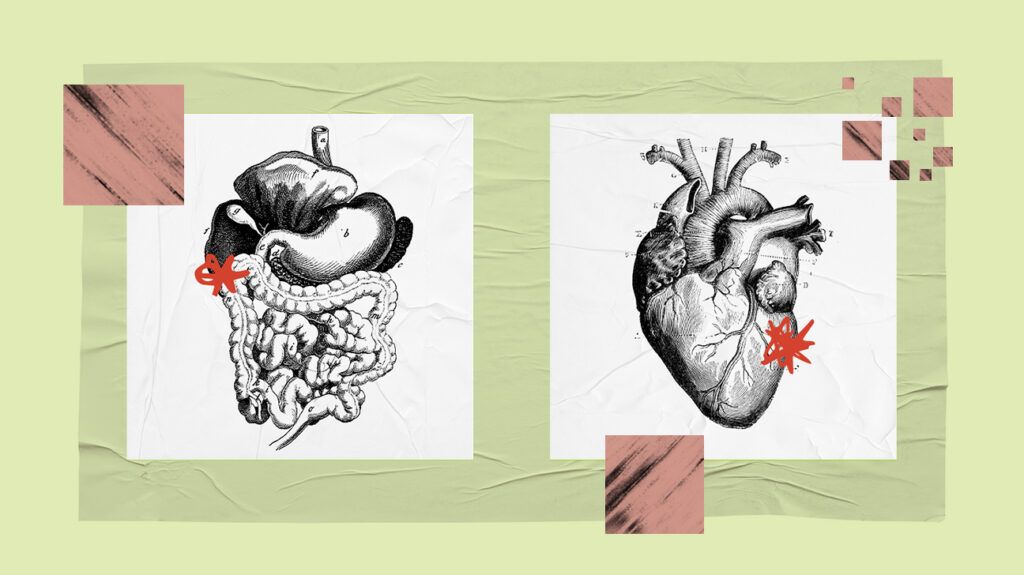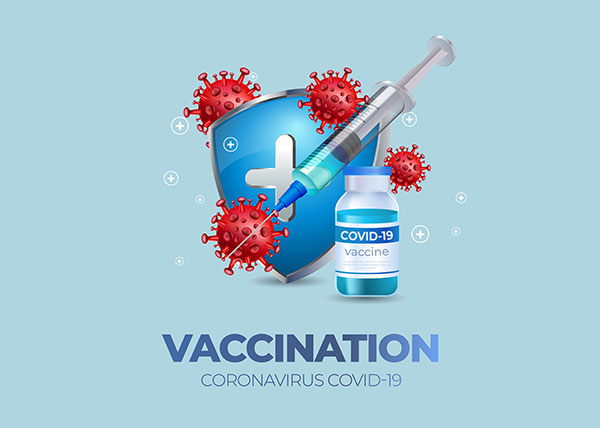Lately, there has been a lot of research looking at the link between the brain and the gut. We wanted to know: Is there a similar link between the heart and the gut? Doctors agree there most certainly is, and mostly it is mediated by the health and balance of the gut microbiome.

In this Special Feature, we explore the strong link between the gut and heart health. Design by MNT; Photography by mikroman6/Getty Images & ilbusca/Getty Images.
A popular adage has it that “you are what you eat.” And every year new research continues to suggest that this idea may, in fact, be correct.
Recently, scientists have been focusing on a potential link between the health of the gut and that of the heart.
Doctors already recommend eating heart-healthy foods, and medical professionals agree that much of the correlation between heart and gut health has to do with the gut microbiome, including its composition, and a toxic byproduct it creates when metabolizing certain foods.
Medical News Today spoke with five experts to get to the bottom of how much gut health truly impacts cardiovascular health.
What is the gut microbiome?
All the experts we spoke to agreed that the gut microbiome can have a profound impact on heart health.
“The gut microbiome is a complex community of trillions of microorganisms, including bacteria, viruses, fungi, and protozoa, that reside in the human digestive tract, primarily in the large intestine (colon),” Dr. Nathaniel E. Lebowitz, a cardiologist with Hackensack University Medical Center in New Jersey explained to MNT.
“These microorganisms can be healthy or unhealthy depending on what we feed them. If they are unhealthy, all of our body’s systems can go haywire. Just like we depend on the microbiome for our health, it depends on us for its health,” he detailed.
“Keeping the microbiome healthy is increasingly found to be critically important for all of our organs — including the heart and arteries,” Dr. Lebowitz continued. “We know that inflammationTrusted Source is possibly the main driver these days when it comes to so many health problems, especially with the heart. The microbiome plays a big role in counteracting inflammation.”
In turn, Dr. Cheng-Han Chen, a board-certified interventional cardiologist and medical director of the Structural Heart Program at MemorialCare Saddleback Medical Center in Laguna Hills, CA, told MNT that:
“There’s more and more research coming out that there is a connection between the composition of someone’s gut flora or the microbiome. There’s a connection between the type, distribution, and relative composition of gut bacteria that someone has and an association with their risk factors for heart disease — that includes high blood pressureTrusted Source, high cholesterolTrusted Source, [and] obesityTrusted Source.”
Past research has linked an unbalanced gut microbiome to an increased risk for several cardiovascular diseases, including coronary heart diseaseTrusted Source, heart failureTrusted Source, strokeTrusted Source, heart attackTrusted Source, hypertensionTrusted Source, and atherosclerosisTrusted Source.
What is TMAO?
Another way in which the gut microbiome can potentially have harmful effects on the heart is through the production of trimethylamine-N-oxide (TMAO)Trusted Source.
“When gut microbes feed on choline — found in red meatTrusted Source, poultry, eggs, [and] certain fish — they make trimethylamineTrusted Source (TMA), which is absorbed into the body and goes to the liver where it is changed into TMAO,” Dr. John P. Higgins, a sports cardiologist at McGovern Medical School at The University of Texas Health Science Center at Houston (UTHealth) explained.
“TMAO is bad because it is associated with cholesterol and artery narrowing plaque in important arteries in the body, especially the coronary arteries which supply blood to the heart. So people with high levels of TMAO are at increased risk of heart attacks or stroke,” he noted.
“Studies have associated TMAO with aspects of inflammation and blood vessel dysfunction,” Dr. Chen added. “It also promotes foam cellsTrusted Source in the blood vessels. All of these different things end up promoting different types of heart disease, such as atherosclerosis, and they can also lead to different aspects of cardiovascular risk factors such as high blood pressure.”
A study published in October 2019 linked TMAO to disease severity and mortality rate in people with peripheral artery diseaseTrusted Source.
Research published in March 2023 reported an increase of TMAO in blood plasma was an independent predictor for major adverse cardiac and cerebrovascular eventsTrusted Source in people who experienced acute myocardial infarction (heart attack).
And a study published in March 2022 correlated elevated TMAO levels with large artery atherosclerotic ischemic strokeTrusted Source.
Why is a well-balanced gut microbiome important?
As the gut microbiome influences not only heart health, but the well-being of the entire body, experts agree that it must be well-balanced for optimal function.
“An easy way to think about the gut microbiome is like a beautiful farm garden,” Monique Richard, a registered dietitian nutritionist and owner of Nutrition-In-Sight explained to MNT.
“The various gut bugs, or microbiota, are like the components of the garden, each having their own job function to contribute to a bountiful harvest. The garden needs components like healthy soil, clean water, proper nutrients, structure, and tender love and care,” she continued the analogy.
According to Dr. Lebowitz:
“If we eat foods that feed the good bacteria — an alkaline diet high in fruits and veggies — we will be fostering the health of a healthy microbiome. Eating foods that contain too much refined carbohydrates, sugar, and processed foods can have the opposite effect and feed bad bacteria which can trigger inflammation that causes disease — and the arteries and the heart are no exception to this. If there is inflammation in the arteries, as an example, cholesterol will stick to it.”
Richard said it is also important to note that each person’s gut microbiota has its function in helping process what we eat and supporting various functions of digestion and systemic function.
“One example includes our gut microbes breaking down compounds into what are called short-chain fatty acidsTrusted Source (SCFAs) like butyrateTrusted Source,” she continued.
“Butyrate has many known benefits which include being anti-inflammatory and cardio-protective. The better equipped our gut is with benefits to nurture the components of our internal ‘garden,’ the more robust the rest of our systems will be since it is all connected and work together,” explained Richard.
Why is fiber heart-healthy?
In addition to following a heart-healthy diet, medical experts agree that getting enough dietary fiber is also required to keep the gut-heart connection thriving.
“Foods that contain fiber are pretty heart healthy — low in saturated fats, low in sodium,” Dr. Chen explained. “And fiber itself is actually food for the gut bacteria. So the more fiber you have, the healthier they will be. They process the fiber and break it down.”
“Fiber-rich foods definitely lower the risk of heart disease and stroke by quite a bit,” Dr. Rudolph Bedford, a board-certified gastroenterologist at Providence Saint John’s Health Center in Santa Monica, CA, told MNT. “Fiber in itself will help to not only take away many of the bad toxins but will also lower the cholesterol level.”
“High fiber diets are great because the microbiome breaks fiber down into beneficial things like short-chain fatty acids which are associated with improved blood pressure, blood sugar, less inflammation, and weight loss — all of which can boost [cardiovascular] health,” Dr. Higgens added.
Past studies have linked higher dietary fiber intake with lowerTrusted Source long-term cardiovascular disease risk, as well as reduced incidence and mortalityTrusted Source from heart disease.
Should you take probiotics or prebiotics?
While eating the right foods can help keep the gut microbiome healthy, there has been a lot of talk over the past few years about taking prebiotic and probiotic supplements to aid with gut health.
In the most basic terms, probiotics are bacteria beneficial to the gut microbiome, while prebiotics are food for those bacteria.
Some foods are natural prebiotics — these include oats, bananas, onions, artichokes, spinach, and chia seeds.
“The problem with probiotics is that they’re a ‘food supplement,’ and much of this is strain-dependent —in other words, what type of strains are within those probiotics,” Dr. Bedford explained. “There’s no doubt that certain strains of probiotics may certainly aid in gut health and may even help in decreasing your risk of cardiovascular disease.”
“But the fact of the matter is that there are just so many different probiotics out there and none of this is regulated by any government agency,”he continued. “It’s somewhat of a challenge to recommend probiotics to patients, depending upon what it is that they’re actually getting. You should definitely speak to your physician before you start a probiotic or prebiotic.”
Healthy gut, healthy heart
With so much evidence pointing to a link between the gut microbiome and cardiovascular health, following a healthy diet rich in foods that aid the good bacteria in the gut is important.
“The gut microbiome itself may cause elevations of cholesterol levels or decreasing cholesterol levels, increasing in other types of chemicals […] such as TMAO, which may increase the risk of heart attacks and strokes and even kidney diseaseTrusted Source,” Dr. Bedford said. “Gut health is eminently connected to the heart.”
“It appears that having a healthy gut is important to heart health, through indirect effects — improving cardiovascular disease risk factors — and direct effects — TMAO-promoting artery-blocking plaque,” Dr. Higgins said. “[It] also boosts [the] immune systemTrusted Source.”
Dr. Lebowitz advised:
“If your diet is healthy then your diet will promote good health. Eating the right foods, for example, fruits, veggies, and cold water fatty fish like salmon, pacific herring, and sardines can help to reduce inflammation and your risk of heart disease. The right nutrition can work wonders — it can even reverse some of the damage already done.”
“The quality of what we consume is important, but so is the environment we consume it from,” Richard said. “Be sure to take time to sit at a table in an inviting environment as often as you can.”
”Take time to slowly chew your food, use your senses to observe, and enjoy the experience of eating. When we are enjoying a meal together around a table — away from technology and convenience — we are feeding so much more than our bodies and gut. These practices are critically more important to the heart, mind, and body than we can measure in a study,” she emphasized.
“It is also important to remember that all things are interconnected,” added Richard. “Nurturing our ‘internal garden’ also requires other ways the heart can thrive and be protected like exposure to nature and fresh air, loving relationships, activities that bring joy and happiness, regular activity, and sunshine.”









